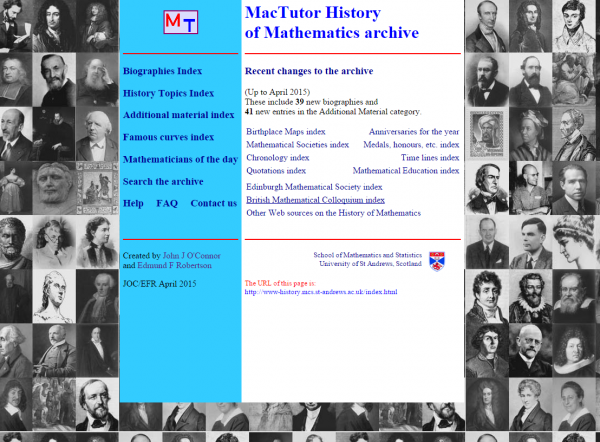Edmund Robertson & John O’Connor of the University of St. Andrews have been honoured by the London Mathematical Society for their pioneering MacTutor History of Mathematics website hosted at St. Andrews.

On 3rd July it was announced that both men have received the Hirst Prize, and Edmund Robertson has been been invited to give the associated Hirst Lectureship, all part of LMS 150th Anniversary celebrations.
As noted in the University of St. Andrews press release, the MacTutor site has grown from its humble origins two decades ago, and now has
“over 2800 detailed biographies of mathematicians and related scientists with bibliographies (primary and secondary sources) accompanying each article, around 150 historical articles on mathematical topics, over 2000 other pages of essays on specific topics and further resources, such as an interactive page on historical curves. The web site has become a hugely successful resource for school-children, undergraduates, graduate students and their teachers all over the world, receiving 10,000,000 hits per month during the academic year, with around 2,000,000 distinct users. It is the first port of call for those interested in the historical side of the mathematical sciences, giving mathematicians direct links to their profession’s past. It bridges the gap between old books and modern journals, and its biographies give lives to names otherwise known only for the theorems to which they are attached. It is the most widely used and influential web-based resource in history of mathematics.”
The site went live in 1994, and its two curators have devoted more time to it in recent years since retiring from their university positions. Edmund writes the great bulk of the biographies and John does the web implementation. (A few biographies have been submitted by others, and published modulo some editorial work to bring them into house style.) John has written his own tools to handle the database, which now contains about 30,000 files, and modestly says, “I am only an amateur programmer/website maker, so I am pleased that our efforts have been approved by so many professionals.”
What is remarkable, as Edmund points out, is that “this has all been done with minimal support from the university, other than our department providing the computer on which the archive runs and our scientific officer doing the continual work to keep that running and the software up-to-date.” Most of the biographies are for mathematicians from earlier eras, from ancient times to the recent past, although they make exceptions for exemplary living practicioners like Andrew Wiles and Barry Mazur.
“We try to make it as international as possible but it certainly has a USA, UK bias simply because obituaries of people from these countries are easier to handle (written in English in journals we have easy access to), Edmund explains. “Also sometimes a particular project leads me to write biographies of many people from one country. For example, we did a project for the 125th anniversary of the Edinburgh Mathematical Society which involved trying to find details of all the members of that Society at a particular time. That produced many biographies of Scottish mathematicians which we added to our Archive. Again I was at a conference in Romania a year ago and found out about a number of Romanian mathematicians who I added.” Indeed, correspondence over the last six months about Irish mathematicians has led to new additions, e.g., Sheila Tinney, the first Irish woman to get a PhD in the mathematical sciences, and Bletchley codebreaker John Herivel, with more such biographies in the pipeline.
In addition to mathematicians both well known and obscure, there are other surprising appearances. Edmund: “You might not expect to find artists like Albrecht Dürer, Leonardo da Vinci, Maurits Escher and Filippo Brunelleschi, or the famous architect Sir Christopher Wren, or the children’s author Lewis Carroll, or Irish President Éamon de Valera, or the famous Florence Nightingale in a mathematics database, but they are all in our Archive and deserve their places!”
Why the name MacTutor? Edmund recalls, “The name came from our MacTutor teaching software which is where our web history archive started. Our MacTutor software was so named because it ran on Macintosh computers using Hypercard (at the time we started a PC wouldn’t have had the facilities for the interactive software we produced).”
Edmund and John won the European Academic Software award in Heidelberg in November 1994 for the MacTutor teaching software. “Before we went to Heidelberg we put the history from our system onto the web which, at that time, was quite new,” Edmund adds. John remembered a problem with another prize from many years ago, “We won an earlier prize for the mathematical teaching version of MacTutor that was sponsored by the US Department of Defence. Then they discovered that we weren’t Americans (the fact that we came from St Andrews should have given them a clue) and they weren’t allowed to give us the money. We should be OK this time with the London Mathematical Society.”
More information
London Mathematical Society Hirst Prize and Lectureship – press release from the University of St Andrews
Announcement of 2015 LMS Prizes (we normally do a round-up of these but haven’t had the time this year)
